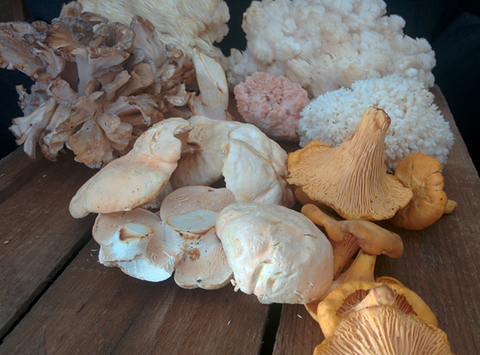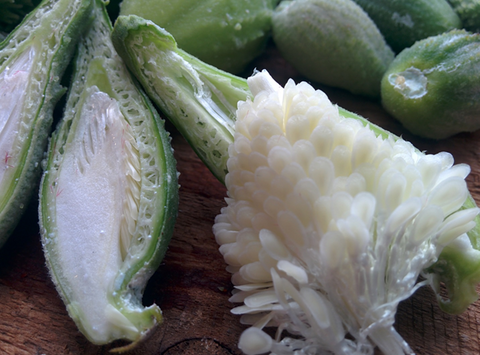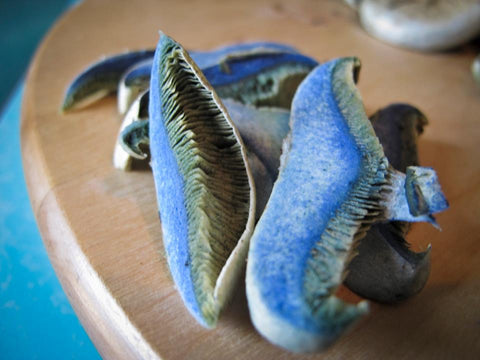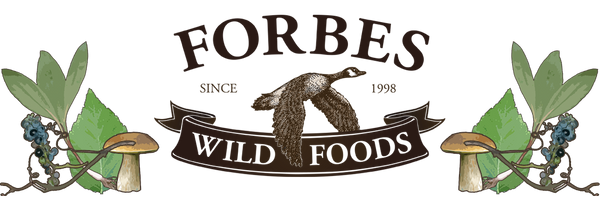Myths About Wild Foods
•Versand am August 01 2018

Dispelling Mysteries of the Bush
1. I saw a slug/bird/deer eating it so it must be edible. 
Often people will say, “I saw some deer eating it, so it is fine" This ignores the fact that all animals have different diets. Just as you can eat chocolate and raisins, but both are toxic to your dog, there are many things that animals can eat that are toxic to us. Always make sure you know what you are harvesting and consuming.
2. Because it is an invasive plant we should remove it.

Some invasive and noxious plants are a real pest: take garlic mustard for example, and the harm it does to maple forests. More often than not invasive plants are simply filling a void left by the clearing of land or loss of native species. While ripping out all the Japanese knotweed can help your garden, this is not the case across the board. Other plants are now integrated into local ecosystems, such as black locusts, which have moved beyond their indigenous range of the Carolinian forest, and naturalized across much of North America, where they provide soil retention and shade. Canada thistle, and Coltsfoot are both examples of "invasives" that thrive in Canada and do not cause any real harm. Until recently, common milkweed, a plant essential for monarch butterflies, was listed as a noxious plant in Ontario.
3. It's okay to harvest at-risk plants in an unsustainable way because they are abundant in my area.

Often at-risk plants will still seem abundant in micro-ecosystems or in secluded regions. However, these plants still suffer massive habitat loss overall, so their perceived abundance is misleading. Plants such as wild leeks can seem abundant when they carpet the forest floor. Unfortunately, leeks still suffer from drastic decline due to urban sprawl, poor regulations, and over harvesting, so harvest responsibly and make sure you keep up on at risk and threatened species.
4. Mushrooms are scarier than plants because the wrong one can kill you.

The truth is there are far more toxic and poisonous plants than mushrooms. There are roughly 10 mushrooms that can kill you, and many more that can make you a bit sick. However, just as there are mushrooms such as the Destroying Angel and Gyromitra, there are countless plants that can cause serious damage. From Giant Hogweed and White Snakeroot, to Yew and American Mandrake, the plant world is loaded with green things waiting to get their vengeance on folks who graze haphazardly. Even with all the risks out in the wild, you are far more likely to get sick from poorly-stored edible food then by a mushroom you picked. By-in-large most of the mushrooms you will find will simply be inedible and unpalatable, however it's always best to know exactly what you're going to consume and never eat lots of something if it's your the first time.
5. Touching a toxic mushroom can poison me or make me sick.

The common assumption that you can get sick from touching toxic mushrooms or from their toxins rubbing off on something edible is completely wrong. This simply is not the case; you need to ingest part of the mushroom for it to have a toxic effect. Keep in mind that the toxic amount could be as little as 1/10th of a gram, but a bit of gooey mushroom on your fingers will not make you sick. In some cases you can even go so far as to do nibble and spit tests to narrow down the edibility of a species, however this is only a suitable way of distinguishing edible mushrooms in a few mushroom families (Russula, boletus and lactarius). With all this said, it is important to separate your finds when you pick because mixing edible and questionable mushrooms may turn into a bad idea if small pieces get mixed up. Please note that while the mushroom pictured above is often shared among memes that talk about toxic mushrooms, it is not itself toxic. However it is pretty much inedible.
6. You can eat wild mushrooms raw.

No mushrooms should be eaten raw, not even the white and brown ones you find at the grocery store. Mushrooms are made up of chitin, a fibrous long chain polymer that makes up the cell walls of fungi. In order for it to be digested, it needs to get broken down by heat, by bringing it up to 212 degrees Fahrenheit. While we do produce some enzymes that help digest chitin, we do not produce enough and because of this, when you eat a raw mushroom you do not get the bulk of the nutrition from them. In addition, many mushrooms may contain compounds that need to be neutralized with heat to be rendered inert, for example morels must be well cooked as they contain compounds that cause cause significant gastric upset. While some mushrooms such as Edulis boletus, chanterelles and commercial agaricus buttons may show up on the occasional menu raw, this is because the cook is unaware of the need to cook, and in small amounts they are unlikely to cause any gastric issues. Last but not least there is the simple issue of food safety, between dirty hands and cross contamination it's better to be safe then making a beeline for the toilet. With that said, many people still eat some commercially cultivated varieties with no adverse effects and you likely don't have to be too concerned about a button mushroom on a vegetable platter.
7. Fiddleheads can be eaten raw.

Fiddleheads often grow along riverbeds and in wet soil. As is the case with many waterborne plants, they can often pick up pathogens and bacteria that require cooking to neutralize. Additionally, fiddleheads have a paper sheath that is loaded with harsh tannins you will want to remove. In order to remove the tannins, fiddleheads are often cooked in several changes of water, to avoid boiling the tannins back into the fiddlehead. It is generally best to avoid any fiddleheads, watercress, cattails, or any other riverside plants that are downstream from agriculture, septic systems, or heavy industry.
8. Because this food has a compound that is beneficial to a particular ailment, eating this food will help treat that ailment.

Often wild foods are touted as medicine, and while they may have some medicinal properties, you should be aware of treating them as preventative medicine or hoping for specific results can cause more harm than good. While wild foods can certainly help folks with a number of ailments, understanding delivery methods, dosage, interactions, and suitability is important. Sometimes food is best left as food.
9. Milkweed is toxic.

There are toxic forms of milkweed; however, common milkweed is perfectly fine to eat. The myth that milkweed is toxic stems back to when a famous forager had mistaken dogbane for milkweed shoots. While the white latex can cause some issues for people with latex sensitivity, milkweed is a lovely plant that can be used a number of different ways, from flower syrups, vegetables, life jackets and medicines, plus it is important to let grow for the sake of the butterflies.
10. You can tell something is edible because it tastes good.

There are many toxic things that are not bitter in the slightest but can make you very sick. The roots of water hemlock taste similar to parsnip, however, it can kill you. Some mushrooms such as death caps may not have an off putting flavour at all but get their names for the deadly punch they pack. Meanwhile there are many lovely wild foods that are bitter, funky, or harsh in ways that may make you question if they are edible, but make a fantastic addition to your diet. Take Chokecherries for example, which are extremely astringent and next to impossible to snack on in the bush but make a lovely jelly or the bitter greens of dandelion. Some bitter foods can help aid in digestion and control appetite.
11. You must cut mushrooms as plucking them hurts the mycelium.

Many folks live by cutting mushrooms from the ground, and while this is a great practice and results in a much cleaner harvest, in regards to the health of the fungus and future harvests it makes very little difference. Massive studies looking at chanterelle yields saw no significant difference between methods, with a slight increase to the yield from plucked mushrooms. If you see a nice patch of morels and do not have the tools to collect them, don’t worry about harming the organism, harvest until they are spilling out of your shirt. Just try to avoid the dirt.
12. Blue staining mushrooms are toxic.

There are very few rules about all mushrooms that stand up to scrutiny and lots of myths about mushroom edibility that are baseless for example one that often pops up is if it stains a silver spoon black its no good. But one of the most common comments is if a mushroom stains blue it will be toxic, in fact there are several blue mushrooms that are great and even more boletes that stain blue that are totally edible. One very common blue staining red capped bolete is the Bi-colour bolete or Baorangia bicolor, a few other edible blue stainers include Lactarius Indigo (pictured above) Neoboletus luridiformis, Neoboletus xanthopus, Imleria badia, Suillellus luridus, Xerocomellus ripariellus.
Happy harvesting!
For more information about wild food and foraging, visit us in person and online today.




Kommentare
2 Kommentare
-

Versandt von Steve | September 24, 2024
-

Versandt von Kristine Steele Pierce | September 24, 2024
Ein Kommentar hinterlassenMilkweed is poisonous. It does contain cardiac poisons – glycosides or cardenolides. This is not a myth from someone eating dogbane. But it’s not highly poisonous, and can be eaten, when cooked. While you are perpetuating the myth that mushrooms are not to be eaten raw. This is not true – at least for all species. I’m not sure who started this one, but I’ve eaten mushrooms raw frequently with no ill effects. Just because they have non digestible components doesn’t mean anything. Plants have many indigestible components that we call fiber!
Dear Forbes,
I am a rather comical Artist and I am busy making animated tiny sculptures for the “Mountain Mushroom Festival” in Irvine Kentucky at the end of April. I classically sculpt little worms of multi colors with fun situations but now I’m doing mushrooms. I absolutely love your articles on edibles and it’s giving me a greater understanding and lots of inspiration to continue pursuing more knowledge of fungus among us. I think I’ll have to give you a call sometime soon and maybe send you a fun sample! We never know what’s under foot so a watchful eye near the soot! Thank you again for your informative wisdom!
Kris Steele 🐸🌻🍄